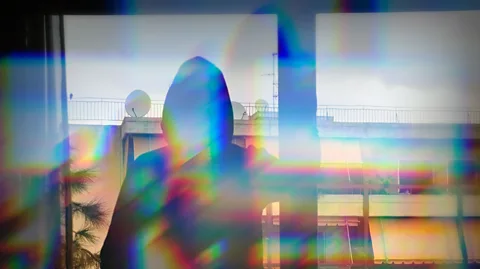Psilocybin and LSD: What I learnt after experiencing 'psychedelic flashbacks'
 Getty Images
Getty ImagesWith psychedelic drug treatments accelerating towards approval in the US and elsewhere, Ed Prideaux investigates a disconcerting after-effect that is poorly understood.
I looked down at the driveway and noticed the paving stones were still moving. I'd taken the drug just the night before and hadn't slept, so I wasn't too surprised to start with.
This was eight years ago, and it was my fourth trip on 1-P LSD, an analogue of LSD that was purchasable online in the UK prior to a legal crackdown in 2016. I decided that this trip might be my last. Psychedelic space was "just a bit much", I concluded – and things thankfully seemed to settle to a delicate peace over the succeeding few days. That is, until I noticed some very strange events in my vision.
In the couple of weeks after the trip – completely sober – I saw the cupboards in my bedroom "breathing" and morphing. Carpets and chairs were covered in fine, greyish particles. Looking at friends' faces, my vision would tunnel in on their central visage like a high-definition camera, and with purple and greenish auras around their heads. The keys on my piano keyboard bore trims of rainbows. And leaning back in my chair one day, my visual field would saturate with dense pockets of blue, with bright halos formed around light fittings.
Having spent an evening watching the wallpaper breathe – glancing away and back and hoping it'd be stationary – I punched in an internet search. Quite quickly, I worked out what might be happening: psychiatrists call it Hallucinogen Persisting Perception Disorder, or HPPD. But a more colloquial term might be "psychedelic flashbacks": the persistence of psychedelic-like perceptual phenomena after the acute effects of a drug have worn off. Within the scientific community, HPPD has been considered to be relatively rare condition, but also one that is poorly understood.
You may also like:
More recently, I've been diving deeper into HPPD to try to understand it better. I've talked to many others who have reported the same symptoms, interviewed psychiatrists and researchers investigating HPPD's causes, and conducted a small research survey to capture people's reports about the personal and emotional consequences.
But my own experiences are not the only reason I've been motivated to investigate HPPD. With psychedelic drug treatments speeding towards approval, it's possible the condition could also become common. In recent years, psychedelics have been gaining mainstream attention around the world for their possible positive therapeutic effects. The state of Oregon in the US, for example, is "pioneering a therapeutic market" for psilocybin (magic mushrooms). And amid positive media coverage, the number of young people in the US consuming psychedelics has reportedly "soared". Around 9% of Americans aged 19-to-30 are estimated to have tried them in the last year, compared to 3% in 2011. (Read more: The worldview changing drugs poised to go mainstream).
So, what exactly is known about HPPD and why it happens?
 Getty Images
Getty Images
At present, researchers don't know exactly how common HPPD or flashback phenomena are, since psychiatrists in clinics only see those who are troubled by the effects. In 2011, an online questionnaire of just under 2,500 s of psychedelics (and other drugs) found that around a quarter reported at least one persistent visual on a constant basis, and 4% to the degree that they were contemplating medical help.
Scientists are also uncertain how HPPD works in the brain. The "disinhibition hypothesis" suggests that psychedelic drugs cause a "decoupling" of visual filters: the brain becomes less able to screen out visual noise. But MRI scans reveal that some people who report HPPD display no differences. Some suggest that HPPD may arise from the ways that psychedelics render the brain more neuroplastic and malleable, such that it "resettles" after a trip in an altered state. Since it's considered a mental health problem, though, HPPD can't be reduced solely to neurochemical processes in the brain: the individual person, their environment and relationships matter too.
We don't know precisely how long people's symptoms tend to last, either. For some, the effects may last a few weeks or months and fade away. Others live with them for a few years or even several decades. One tentative estimate of clinical HPPD patients suggests that 50% may recover within five years.
In my early urgent reading, I learned that medications can be limited: nothing curative, only addictive and side-effect laden benzodiazepines, repurposed anti-Parkinson's drugs, SSRIs, and antiepileptics, which may be life-savers for some, or have minimal or damaging effects for others.
At the time, this news was difficult to take. I took a screenshot of the HPPD Wikipedia page and messaged it to a friend I'd tripped with. "What have I done">window._taboola = window._taboola || []; _taboola.push({ mode: 'alternating-thumbnails-a', container: 'taboola-below-article', placement: 'Below Article', target_type: 'mix' });
